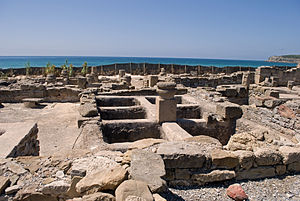鱼酱
鱼酱(拉丁语:garum)是一种把渔获发酵而成的调味料[1],在环地中海地区,如:古希腊、古罗马及拜占廷帝国的饮食里均有使用。相传在古代的腓尼基人就已经懂得制作鱼酱,并传播至古希腊,然后到环地中海地区。

生产
编辑鱼酱的发酵原理是透过小鱼的肠脏内的细菌引起的细菌发酵过程制作[2]。渔民把渔获按其种类及部分而分类,让生产商可以选择所需的成分[3]。
参见
编辑参考资料
编辑- ^ Zahn, R. "Garum". Real-Encyclopaedia der klassischen Altertumswissenschaft 1st Series. 1912, (7): 841–849 (德语).
- ^ Robert I, Curtis. "In Defense of Garum". The Classical Journal. 1983, 78 (3): 232–240 (英语).
- ^ Rober I., Curtis. The Garum Shop of Pompeii. Cronache Pompeiane. 1979, XXXI (94): 5–23.
延伸阅读
编辑- Atik, S. "Marcus Gavius Apicius ve Garum" III-IV. Ulusal Arkeolojik Arastirmalar Sempozyumu, Anadolu / Anatolia Ek Dizi No. 2 / Suppl. Series No. 2, 15–25, Ankara, 2008.
- Butterworth, Alex and Ray Laurence. Pompeii: The Living City. New York, St. Martin's Press, 2005.
- Downie D (2003) "A Roman Anchovy's Tale" (页面存档备份,存于互联网档案馆) Gastronomica - The Journal of Food and Culture, 3 (2).
- Grant, Mark: Roman Cookery (Serif, London, 2008). [1]
- McCann, A.M. (1994). "The Roman Port of Cosa",(273 BC), Scientific American, Ancient Cities, pp. 92–99, by Anna Marguerite McCann. Covers: modifying harbor, for the garum industry, amphora factory, hydraulic concrete, of "Pozzolana mortar" and the five piers, of the Cosa harbor, the lighthouse on pier 5, diagrams, and photographs. Height of Port city: 100 BC. For: Garum Industry at port of Cosa, Italy, 273 BC.'
- Smith AF (1998) "From Garum to Ketchup. A Spicy Tale of Two Fish Sauces" (页面存档备份,存于互联网档案馆) Pages 299–306 in: Harlan Walker (Ed.) Food from the Waters, Proceedings of the Oxford Symposium on Food and Cookery 1997. ISBN 9780907325895.
外部链接
编辑- James Grout: Garum, part of the Encyclopædia Romana (页面存档备份,存于互联网档案馆)